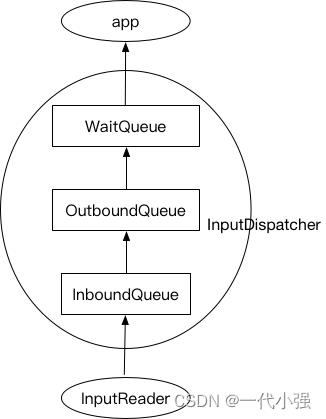Android带你细看Android input系统中ANR的机制
Posted 一代小强
tags:
篇首语:本文由小常识网(cha138.com)小编为大家整理,主要介绍了Android带你细看Android input系统中ANR的机制相关的知识,希望对你有一定的参考价值。
“本文基于android13源码,分析Input系统的Anr实现原理“
在文章之前,先提几个问题:
- 如果在activity任意周期(onCreate,onResume等),同步执行耗时超过5s(ANR时间)的任务,期间不进行点击,那会触发ANR吗?
- 如果在button点击的时候,在onClick回调同步执行耗时超过5s的任务。点击一次会触发ANR吗?点击2次呢,3次呢?
1、ANR 分类
首先看一下anr的分类:
- Input ANR:按键或触摸事件在5s内没有相应,主要在activity、fragment中。
- Service anr:前台service 响应时间是20s,后台service是200s。
- Broadcast anr:前台广播是10s,后台广播是60s。
- ContentProvider anr:publish执行未在10s内完成。
- startForgoundService:应用调用startForegroundService,然后5s内未调用startForeground出现ANR或者Crash
有些小伙伴可能好奇,为啥没有Activity ANR的分类?Activity ANR准确的来说是——Input系统检测,触发activity 的anr。所以本文将通过input系统来讲述Android是如何触发activity的anr。
2、InputDispatcher
在了解Input Anr 原理之前,我们简单了解一下InputDispatcher是如何分发按键事件的。
Inputdispatcher中,在线程里面调用到dispatchOnce方法,该方法中主要做:
- 通过dispatchOnceInnerLocked(),取出mInboundQueue 里面的 EventEntry事件
- 通过enqueueDispatchEntryLocked(),生成事件DispatchEntry并加入connection的
outbound队列。 - 通过startDispatchCycleLocked(),从outboundQueue中取出事件DispatchEntry, 重新放入connection的
waitQueue队列。同时通过inputPublisher.publishKeyEvent() 方法将按键事件分发给java层。 - 通过processAnrsLocked(),判断是否需要触发ANR。
按键事件存储在3个queue中:
- InputDispatcher的mInboundQueue:存储的是从InputReader 送来的输入事件。
- Connection的outboundQueue:该队列是存储即将要发送给应用的输入事件。
- Connection的waitQueue:队列存储的是已经发给应用的事件,但是应用还未处理完成的。

2.1 dispatchOnce
dispatchOnce() 中主要就是调用如下的两个方法:
- 事件分发:dispatchOnceInnerLocked()
- 检查ANR:processAnrsLocked()
> frameworks/native/services/inputflinger/dispatcher/InputDispatcher.cpp
void InputDispatcher::dispatchOnce()
nsecs_t nextWakeupTime = LONG_LONG_MAX;
...
// 如果没有挂起的命令,则运行调度循环。调度循环可能会将命令排入队列,以便稍后运行。
if (!haveCommandsLocked())
dispatchOnceInnerLocked(&nextWakeupTime);
// 运行所有挂起的命令(如果有)。如果运行了任何命令,则强制下一次轮询立即唤醒。
if (runCommandsLockedInterruptable())
nextWakeupTime = LONG_LONG_MIN;
...
// 我们可能必须早点醒来以检查应用程序是否正处于anr
const nsecs_t nextAnrCheck = processAnrsLocked();
// 等待回调、超时或唤醒。
nsecs_t currentTime = now();
int timeoutMillis = toMillisecondTimeoutDelay(currentTime, nextWakeupTime);
mLooper->pollOnce(timeoutMillis);
我们先简单回顾下事件分发过程
3、事件分发
3.1 dispatchOnceInnerLocked
该方法主要是:
-
从mInboundQueue 中取出mPendingEvent
-
通过mPendingEvent的type决定事件类型和分发方式。比如当前是key类型。
主要代码如下:
> frameworks/native/services/inputflinger/dispatcher/InputDispatcher.cpp
void InputDispatcher::dispatchOnceInnerLocked(nsecs_t* nextWakeupTime)
nsecs_t currentTime = now();
...
// 优化应用切换的延迟。本质上,当按下应用程序切换键(HOME)时,我们会开始一个短暂的超时。
// 当它过期时,我们会抢占调度并删除所有其他挂起的事件。
bool isAppSwitchDue = mAppSwitchDueTime <= currentTime;
// 当前没有PendingEvent(即EventEntry),则取一个
if (!mPendingEvent)
...
// mInboundQueue不为空 ,就从队列前面取一个PendingEvent
mPendingEvent = mInboundQueue.front();
mInboundQueue.pop_front();
traceInboundQueueLengthLocked();
...
3.2 enqueueDispatchEntryLocked
enqueueDispatchEntryLocked() 会创建一个新的DispatchEntry,然后将DispatchEntry 加入到connection#outboundQueue 中
> frameworks/native/services/inputflinger/dispatcher/InputDispatcher.cpp
void InputDispatcher::enqueueDispatchEntryLocked(const sp<Connection>& connection,
std::shared_ptr<EventEntry> eventEntry,
const InputTarget& inputTarget,
int32_t dispatchMode)
// 这是一个新事件。将新的调度条目排队到此连接的出站队列中。
std::unique_ptr<DispatchEntry> dispatchEntry =
createDispatchEntry(inputTarget, eventEntry, inputTargetFlags);
...
// 将生成的dispatchEntry 加入到 connection的outboundQueue 中
connection->outboundQueue.push_back(dispatchEntry.release());
traceOutboundQueueLength(*connection);
3.3 startDispatchCycleLocked
该方法主要通过connection 发布最终的事件,至此,InputDispatcher完成事件的发布,并且将发布的事件保存在connection的waitQueue中。
> frameworks/native/services/inputflinger/dispatcher/InputDispatcher.cpp
void InputDispatcher::startDispatchCycleLocked(nsecs_t currentTime,
const sp<Connection>& connection)
while (connection->status == Connection::Status::NORMAL && !connection->outboundQueue.empty())
// 从outboundQueue 队列中取出 DispatchEntry
DispatchEntry* dispatchEntry = connection->outboundQueue.front();
const std::chrono::nanoseconds timeout = getDispatchingTimeoutLocked(connection);
// 设置超时时间
dispatchEntry->timeoutTime = currentTime + timeout.count();
// 发布事件
status_t status;
const EventEntry& eventEntry = *(dispatchEntry->eventEntry);
...
// 在等待队列上重新排队事件。
connection->outboundQueue.erase(std::remove(connection->outboundQueue.begin(),
connection->outboundQueue.end(),
dispatchEntry));
// 在waitQueue 尾部重新插入
connection->waitQueue.push_back(dispatchEntry);
if (connection->responsive)
// 插入事件对应的anr检查时间
mAnrTracker.insert(dispatchEntry->timeoutTime,
connection->inputChannel->getConnectionToken());
3.4 ANR超时时间
由 startDispatchCycleLocked() 方法,知道是通过getDispatchingTimeoutLocked 获取到超时时间
> frameworks/native/services/inputflinger/dispatcher/InputDispatcher.cpp
// 如果没有用于确定适当调度超时的焦点应用程序或暂停窗口,则默认输入调度超时。
const std::chrono::duration DEFAULT_INPUT_DISPATCHING_TIMEOUT = std::chrono::milliseconds(
android::os::IInputConstants::UNMULTIPLIED_DEFAULT_DISPATCHING_TIMEOUT_MILLIS *
HwTimeoutMultiplier());
std::chrono::nanoseconds InputDispatcher::getDispatchingTimeoutLocked(
const sp<Connection>& connection)
if (connection->monitor)
// 返回监控的超时时间
return mMonitorDispatchingTimeout;
const sp<WindowInfoHandle> window =
getWindowHandleLocked(connection->inputChannel->getConnectionToken());
if (window != nullptr)
// 可以找到focused Window
return window->getDispatchingTimeout(DEFAULT_INPUT_DISPATCHING_TIMEOUT);
// 获取默认的值
return DEFAULT_INPUT_DISPATCHING_TIMEOUT;
WindowInfoHandle#getDispatchingTimeout 返回的值如下
> libs/gui/include/gui/WindowInfo.h
class WindowInfoHandle : public RefBase
inline std::chrono::nanoseconds getDispatchingTimeout(
std::chrono::nanoseconds defaultValue) const
return mInfo.token ? std::chrono::nanoseconds(mInfo.dispatchingTimeout) : defaultValue;
struct WindowInfo : public Parcelable
std::chrono::nanoseconds dispatchingTimeout = std::chrono::seconds(5); // 5 秒
DEFAULT_INPUT_DISPATCHING_TIMEOUT 主要由UNMULTIPLIED_DEFAULT_DISPATCHING_TIMEOUT_MILLIS * HwTimeoutMultiplier() 计算得到
UNMULTIPLIED_DEFAULT_DISPATCHING_TIMEOUT_MILLIS的值如下
> android/os/IInputConstants.h
class IInputConstants : public ::android::IInterface
public:
enum : int32_t UNMULTIPLIED_DEFAULT_DISPATCHING_TIMEOUT_MILLIS = 5000 ;
....
; // class IInputConstants
HwTimeoutMultiplier() 方法定义如下,即读ro.hw_timeout_multiplier 属性值,默认是1。
> system/libbase/include/android-base/properties.h
static inline int HwTimeoutMultiplier()
return android::base::GetIntProperty("ro.hw_timeout_multiplier", 1);
3.5 调用栈
native层的事件分发调用栈如下
libs/input/InputTransport.cpp : InputPublisher::publishMotionEvent()
services/inputflinger/dispatcher/InputDispatcher.cpp : InputDispatcher::startDispatchCycleLocked()
services/inputflinger/dispatcher/InputDispatcher.cpp : InputDispatcher::enqueueDispatchEntriesLocked()
services/inputflinger/dispatcher/InputDispatcher.cpp : InputDispatcher::prepareDispatchCycleLocked()
services/inputflinger/dispatcher/InputDispatcher.cpp : InputDispatcher::dispatchKeyLocked()
services/inputflinger/dispatcher/InputDispatcher.cpp : InputDispatcher::dispatchOnceInnerLocked()
services/inputflinger/dispatcher/InputDispatcher.cpp : InputDispatcher::dispatchOnce()
services/inputflinger/dispatcher/InputDispatcher.cpp : InputDispatcher::start()
4、ANR触发
在dispatchOnce(),会调用processAnrsLocked 方法来决定是否需要触发anr
> frameworks/native/services/inputflinger/dispatcher/InputDispatcher.cpp
void InputDispatcher::dispatchOnce()
...
// 我们可能必须早点醒来以检查应用程序是否正处于anr
const nsecs_t nextAnrCheck = processAnrsLocked();
....
4.1 processAnrsLocked
该方法是用于检查队列中是否有太旧的事件,如果存在就触发ANR
> frameworks/native/services/inputflinger/dispatcher/InputDispatcher.cpp
// 检查是否有任何连接的等待队列具有太旧的事件。如果我们等待事件被确认的时间超过窗口超时,
// 请引发 ANR。返回我们下次应该醒来的时间。
nsecs_t InputDispatcher::processAnrsLocked()
const nsecs_t currentTime = now();
nsecs_t nextAnrCheck = LONG_LONG_MAX; // 下一次检查anr的时间
// 检查我们是否正在等待一个聚焦窗口出现。如果等待时间过长就报 ANR
if (mNoFocusedWindowTimeoutTime.has_value() && mAwaitedFocusedApplication != nullptr)
if (currentTime >= *mNoFocusedWindowTimeoutTime)
// 场景1: 触发noFocusedWindow的anr
processNoFocusedWindowAnrLocked();
mAwaitedFocusedApplication.reset();
mNoFocusedWindowTimeoutTime = std::nullopt;
return LONG_LONG_MIN;
else
// 请继续等待。我们将在mNoFocusedWindowTimeoutTime到来时放弃该事件。
nextAnrCheck = *mNoFocusedWindowTimeoutTime;
// 检查是否有任何连接 ANR 到期,mAnrTracker 中保存所有已分发事件(未被确认消费的事件)的超时时间
nextAnrCheck = std::min(nextAnrCheck, mAnrTracker.firstTimeout());
if (currentTime < nextAnrCheck) // 最有可能的情况
// 一切正常,在 nextAnrCheck 再检查一次
return nextAnrCheck;
// 如果我们到达这里,则连接无响应。
sp<Connection> connection = getConnectionLocked(mAnrTracker.firstToken());
// 停止为此无响应的连接唤醒
mAnrTracker.eraseToken(connection->inputChannel->getConnectionToken());
// 场景2: 触发ANR
onAnrLocked(connection);
return LONG_LONG_MIN;
其中,mAnrTracker 存储已经成功分发给应用的事件。详情见startDispatchCycleLocked() 方法。
mNoFocusedWindowTimeoutTime 是在findFocusedWindowTargetsLocked() 方法中赋值的,在分发事件的时候会调用到findFocusedWindowTargetsLocked() :
> frameworks/native/services/inputflinger/dispatcher/InputDispatcher.cpp
InputEventInjectionResult InputDispatcher::findFocusedWindowTargetsLocked(
nsecs_t currentTime, const EventEntry& entry, std::vector<InputTarget>& inputTargets,
nsecs_t* nextWakeupTime)
...
// 兼容性行为:如果存在焦点应用程序但没有焦点窗口,则引发 ANR。只有当我们有重点事件要调度时,才开始计数。
// 如果我们开始通过触摸(应用程序开关)与另一个应用程序交互,则 ANR 将被取消。
// 如果将“无聚焦窗口 ANR”移动到策略中,则可以删除此代码。输入不知道应用是否应具有焦点窗口。
if (focusedWindowHandle == nullptr && focusedApplicationHandle != nullptr)
if (!mNoFocusedWindowTimeoutTime.has_value())
// 发现没有focusedWindow,就添加ANR定时器。
std::chrono::nanoseconds timeout = focusedApplicationHandle->getDispatchingTimeout(
DEFAULT_INPUT_DISPATCHING_TIMEOUT);
mNoFocusedWindowTimeoutTime = currentTime + timeout.count();
....
return InputEventInjectionResult::PENDING;
// 找到一个focusedwindow,就取消ANR定时器
resetNoFocusedWindowTimeoutLocked();
...
void InputDispatcher::resetNoFocusedWindowTimeoutLocked()
// 取消ANR定时器
mNoFocusedWindowTimeoutTime = std::nullopt;
mAwaitedFocusedApplication.reset();
从上面的代码我们能小结出两个场景ANR的条件:
- 有等待获取焦点的应用:当前时间超过Timeout,调用processNoFocusedWindowAnrLocked() 进一步确认
- 存在window:当前时间超过事件响应的超时时间。调用onAnrLocked() 进一步确认。
4.2 processNoFocusedWindowAnrLocked
该方法触发anr的条件是:
- 当前关注的应用程序必须与我们等待的应用程序相同。
- 确保我们仍然没有聚焦窗口。
processNoFocusedWindowAnrLocked 最后也是调用到onAnrLocked。
> frameworks/native/services/inputflinger/dispatcher/InputDispatcher.cpp
// 如果没有聚焦窗口,请触发ANR。在触发 ANR 之前,请执行最终状态检查:
void InputDispatcher::processNoFocusedWindowAnrLocked()
std::shared_ptr<InputApplicationHandle> focusedApplication =
getValueByKey(mFocusedApplicationHandlesByDisplay, mAwaitedApplicationDisplayId);
if (focusedApplication == nullptr ||
focusedApplication->getApplicationToken() !=
mAwaitedFocusedApplication->getApplicationToken())
// 出乎意料,因为当前焦点应用程序已被更改,我们应该重置 ANR 计时器
return;
const sp<WindowInfoHandle>& focusedWindowHandle =
getFocusedWindowHandleLocked(mAwaitedApplicationDisplayId);
if (focusedWindowHandle != nullptr)
//我们现在有一个焦点window,不需要再触发ANR
return;
onAnrLocked(mAwaitedFocusedApplication);
onAnrLocked 有两种实现:
- 能找到当前focus的window
- 找不到当前focus的window,但是可以找到当前前台应用。
我们先看情况1
4.3 onAnrLocked(connection)
> frameworks/native/services/inputflinger/dispatcher/InputDispatcher.cpp
//情况1: 能找到window的情况
void InputDispatcher::onAnrLocked(const sp<Connection>& connection)
// 由于我们允许策略延长超时,因此 waitQueue 可能已经再次正常运行。在这种情况下不要触发 ANR
if (connection->waitQueue.empty())
return;
// “最旧的条目”是首次发送到应用程序的条目。但是,该条目可能不是导致超时发生的条目。
// 一种可能性是窗口超时已更改。这可能会导致较新的条目在已分派的条目之前超时。
// 在这种情况下,最新条目会导致 ANR。但很有可能,该应用程序会线性处理事件。
// 因此,提供有关最早条目的信息似乎是最有用的。
DispatchEntry* oldestEntry = *connection->waitQueue.begin();
// 获取到超时时长
const nsecs_t currentWait = now() - oldestEntry->deliveryTime;
std::string reason =
android::base::StringPrintf("%s is not responding. Waited %" PRId64 "ms for %s",
connection->inputChannel->getName().c_str(),
ns2ms(currentWait),
oldestEntry->eventEntry->getDescription().c_str());
sp<IBinder> connectionToken = connection->inputChannel->getConnectionToken();
// 生成 reason 报告
updateLastAnrStateLocked(getWindowHandleLocked(connectionToken), reason);
processConnectionUnresponsiveLocked(*connection, std::move(reason));
// 停止唤醒此连接上的事件,它已经没有响应
cancelEventsForAnrLocked(connection);
// 捕获 ANR 时 InputDispatcher 状态的记录。
void InputDispatcher::updateLastAnrStateLocked(const std::string& windowLabel,
const std::string& reason)
....
dumpDispatchStateLocked(mLastAnrState);
4.3.1 dumpDispatchStateLocked
dumpDispatchStateLocked 函数主要打印当前window和事件队列信息。执行dumpsys input 命令,dumpDispatchStateLocked函数输出的内容如下:
Input Dispatcher State:
....
PendingEvent: <none> // 当前正在调度转储事件。
InboundQueue: <empty> // Inbound 队列
ReplacedKeys: <empty>
Connections:
317: channelName='cf1eda9 com.example.anrdemo/com.example.anrdemo.MainActivity (server